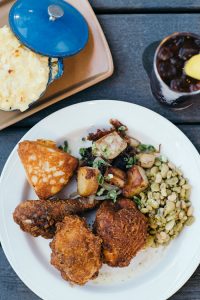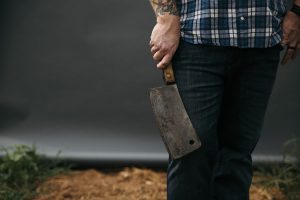When you see Kevin Gillespie on television or read his earlier interviews, the same phrase seems to come up, “Defending Southern Food.” It reminds me of the oath our soldiers take when they enter the military, they vow to protect us from “enemies both foreign and domestic.”
[dropcap letter=”T”]hat’s a good way to think about the defense of Southern Food. Our regional cuisines have been under attack for quite some time. They have been described as un-healthy because we use lard and fatback or because we are fond of batter and hot grease. But there are other threats. Southern cooking is all the rage right now across the country and around the world. The troubling cousin of popularity is homogeny. Remember when it seemed you couldn’t go into any restaurant in middle-America and not be greeted with someone’s idea of “Cajun” cooking? Remember when there was no escaping “blackened” items on nearly every menu? Without chefs like Kevin, Southern fare might face a similar, grim fate.
“We started using that term [Defending Southern Food] a few years ago mostly to instill a sense a pride for this place that we feel is worth “defending. We have always been identified by outsiders mostly by the foods we are famous for, some of them good and some of them not so good. That being said, forgetting our roots, culinarily-speaking, seemed like a terrible possibility given the new exposure we in the South have gotten. Defending Southern Food is another way of saying ‘just because we now get our moment in the sun, let’s not forget what got us here in the first place.’”
In our minds the food and the people of the South are one and the same.
When you listen to Kevin for a while you start to realize just how far down this rabbit hole he is willing to chase this notion of defense. Kevin sees Southern food as a vast palate of very different cuisines. Even within his own family and home state there are two very different food traditions. His Dad’s side of the family is from the Appalachian hill country where money is tight and meat is a luxury while his Mom’s folks come from Coastal Georgia where plantation culture rules the kitchens and dining tables are monuments to plenty. At a dinner of his Mother’s ancestors, fried, young chickens might feature prominently at the center of the table, but that’s an expensive way to serve a lot of meat to just a few people. Plus, those chickens, fresh from the grease and beautifully battered, surely had a few more good egg-laying years ahead of them and eating them while they are young and tender would be considered wasteful, if not downright extravagant in the hills. A whole hen might find her way to an Appalachian table, but she would be beyond her laying prime and in need of slow braising to make her tender enough to eat. Instead of feeding four or so people, that hen would be stewed with lots of vegetables and served over plenty of rice so she could feed an easy dozen. Both fried chicken and stewed hen are “Southern” dishes, but in reality they come from different worlds.
[perfectpullquote align=”left” bordertop=”false” cite=”” link=”” color=”” class=”” size=””]So this posits the question, “Are these ‘exotic’ influences a threat to Southern food, or are they just the natural progression of it?”[/perfectpullquote]Beyond Georgia, the breadth of Southern fare continues – salted, dry-cured hams in Virginia; pit-cooked steer in West Texas; boiled crawfish in Louisiana; deep-fried catfish in Arkansas; “Country Captain” chicken with curry and raisins in South Carolina’s Low Country; Delta tamales and fried “Pan Trout” (which is neither trout, nor cooked in a pan) in Mississippi; dry-rubbed ribs in Memphis; oyster stew or “Coon and Collards” in Alabama – these dishes wouldn’t have any relation to each other if they weren’t all lumped into the catch all category of “Southern” food. What influences have the 20th and 21st centuries had on Southern cuisine? In the Mississippi Delta you’re likely to hear nothing but southern accents in a kitchen full of women making Lebanese kibbeh. Texas is as unapologetically “southern” as any place I know and their jalapeño cornbread fits nicely alongside a pot of greens, but the influence from Mexico couldn’t be more apparent. Have you had a Vietnamese Banh Mi in Biloxi? It’s a nearly perfect modernization of the classic Po-boy. The South has been a melting pot from the beginning. The culinary traditions of Spain, France, West-Africa, the British and Caribbean Islands melded around the available ingredients to create the core of what we identify as classic southern cuisine today.
 At his restaurant in Decatur, Revival, the driving theme of the menu is presenting the authentic dishes of his family and birthplace, prepared with the skill of great chefs and using the finest, seasonal ingredients available. Kevin is serving Meat & Three plates for lunch and unapologetically direct dinner items such as Fried Chicken and Pot Pie alongside Cabbage with Ham, Mac n’ Cheese and Green Tomato Casserole.
At his restaurant in Decatur, Revival, the driving theme of the menu is presenting the authentic dishes of his family and birthplace, prepared with the skill of great chefs and using the finest, seasonal ingredients available. Kevin is serving Meat & Three plates for lunch and unapologetically direct dinner items such as Fried Chicken and Pot Pie alongside Cabbage with Ham, Mac n’ Cheese and Green Tomato Casserole.
The Appalachian dishes of his grandparents were born of economy, availability of ingredients and the need to stretch a dollar from meal to meal. This usually meant using proteins as seasonings for larger portions of vegetables and starches. A little ham to season the beans; a little chicken in the pot pie; a little beef in a hearty vegetable stew; that was the old way and it kept the food budget low and the family full. But the demands and desires of the high-end diner don’t align with budget-conscious ethos of Appalachian cuisine and to be realistic, Kevin’s customer base isn’t made up of folks on a tight budget. People come to his restaurants to be wowed and they don’t mind paying for it. This dichotomy of luxury and economy is the tightrope Kevin and his crew must walk.
The fairly strict adhesion to classic Southern dishes at Revival is perfect foil to the high-wire act on display every night at his first solo restaurant, Gunshow. It’s part medicine-show theater, part pop-up restaurant and part dim sum parlor tucked into a cozy, corner space in East Atlanta’s Glenwood Park neighborhood. Each night, the culinary team of three chefs make small plate dishes and personally hawk them to guests. The chefs concept, prep and cook their own menus, make about ten portions at a time and roll their creations on carts through the dining room where guests can select their dinner, one delicious dish at a time. To add even more drama, guest chefs (like Oxford, Mississippi’s John Currence or North Carolina’s Vivian Howard) are occasionally invited to participate as “Hired Guns” and given carte blanche to let their imaginations run as fast as their knives and pans can take them.
In a crowded field of gourmet restaurants, Kevin has found a niche that no one has been able to replicate.

Having a bully-pulpit to expound on food philosophy is a new luxury for Kevin. Prior to his rocket-like rise to magazine covers and discussion panels at food and wine festivals, he put in the requisite hours to pay his dues. Between culinary school graduation day and his near-victory on the sixth season of Bravo! network’s Top Chef, Kevin worked the stoves at places both funky (TWO Urban Licks) and formal (Atlanta Grill at the Ritz Carlton) in Atlanta and even took a sabbatical from his job at Woodfire Grill to experience the West Coast where he helmed Fife Restaurant in Portland, Oregon. But Atlanta was always “home” and in 2009 he returned to familiar faces and places and took up the spot he had left at Woodfire. Shortly after his return, he was promoted to Executive Chef. It was there he found his groove, garnering accolades from local and national organizations including a Semi-finalist nod as “Rising Star Chef of the Year” from the James Beard Foundation.
It was also as leader of the Woodfire kitchen where he caught the eye of the casting crew at Bravo! Network’s Top Chef. On the show, his smile and southern charm delighted audiences who cheered him on through the most victories in quick-fire and elimination challenges in the history of the show.
Although brothers Michael and Bryan Voltaggio took the two top spots, audiences and diners couldn’t get enough of Kevin. His apparent ease in the spotlight led to even more opportunities like delivering the keynote address at the conference of Les Dames d’Escoffier, a worldwide philanthropic society of professional women leaders in the fields of food, fine beverage and hospitality and his appearance on Top Chef Duels where he took on perennial favorite ambassador of Southern cooking, Art Smith.
I asked Art about his experience cooking with (and losing to) Kevin and he responded in the most Art Smith way possible. “Kevin is a Southern force to be reckoned with. He might challenge you to a p***ing contest to who’s more Southern and he probably will win. I got beat but I gained a dear sweet Southern friend.”

Among the Southern family of Chefs and cooks there is a young, red-headed man that always has a smirk on his big, red-bearded face and he’s always up to something delicious (and it’s got lard in it). Kevin is a Southern force to be reckoned with.
Kevin’s time on the celebrity circuit cuts deeply into his time at the stove in his restaurants, but he’s pretty OK with that…sort-of. “I miss the camaraderie more than anything. Truth is, I never liked the idea of work yourself to death then go get tore up afterward, and start all over tomorrow. I miss cooking, but I get a chance to do that more at home now and when we are working on new menus. The thing that I cannot replace is that feeling of brotherhood that you get when you stand next to someone day in and day out. Nowadays I am just the boss, and maybe not even that to some people. To them I am just the owner. There are so many people in our company now, and I don’t have the personal relationship that I used to have with everyone. They say it’s lonely at the top. I can attest to that.”
Like I said when I started this story, I didn’t get to cook with Kevin. Maybe I will someday: and if I do, I know there will be three things involved: a casserole, some war stories from the back-of-the-house and some deep reverence for the South that produced us both.
Written by Tom Ramsey / Photography by Growl Brothers
www.gunshowatl.com www.revivaldecatur.com
[separator type=”thin”]
Connecting With the Land
By the age of five, Kevin Gillespie had already learned a valuable lesson from his father about food. “My dad helped me understand how something that seemed so very brutal was a real necessity.” It was after a hunting trip, The first time he saw a deer being processed it did shock him a little, but as he grew to understand the hunt, it became something he looked forward to. “I didn’t become desensitized at all; rather I began to understand the connection of how food got to my plate.”
These lessons learned as a child – the hunting and dressing of animals – is something this chef carries on in his restaurants and in the way he thinks about food in general. “We get the luxury of getting meat that has been broken down now,” he explains. “I believe it makes you a better cook to know where your meat comes from.”
 Gillespie hunts for the sake of food, because it connects him to the world. “…as you physically walk over the land – it’s more than the sporting aspect of it all, because it’s not that for me. Most folks aren’t brought up to understand that cycle of the whole life and death component. In this world we live in, we don’t need to waste the very things that have made the ultimate sacrifice.”
Gillespie hunts for the sake of food, because it connects him to the world. “…as you physically walk over the land – it’s more than the sporting aspect of it all, because it’s not that for me. Most folks aren’t brought up to understand that cycle of the whole life and death component. In this world we live in, we don’t need to waste the very things that have made the ultimate sacrifice.”
The intimacy with the hunt comes after you hike 20 miles and hunt that quarry – and carry it out back out on your shoulders it becomes a very intimate experience.

Hunting remains a big part of Gillespie’s life. “I hunt with my family – my dad and my uncles – in my free time – which is not vast anymore – because I prefer to eat things that I have a stronger connection with, when possible. I like to know where the food on my table food comes from and I don’t like going to the grocery store for my food, either.”
Knowing that someone he knew, or he himself, had foraged, hunted or fished to put that food on the table. That distinctive feeling made him more aware of what it took to get food to the table which in turn fed his curiosity about not only that food but about what he saw as the magic of all foods and how to prepare them.
“It was always about more than just being hungry and wanting to eat. What I saw when people cooked, seemed like magic to me. And, the people that could do it well, created that magic – that’s what I wanted!”
Written by Elizabeth Tate / Photography by Growl Brothers
